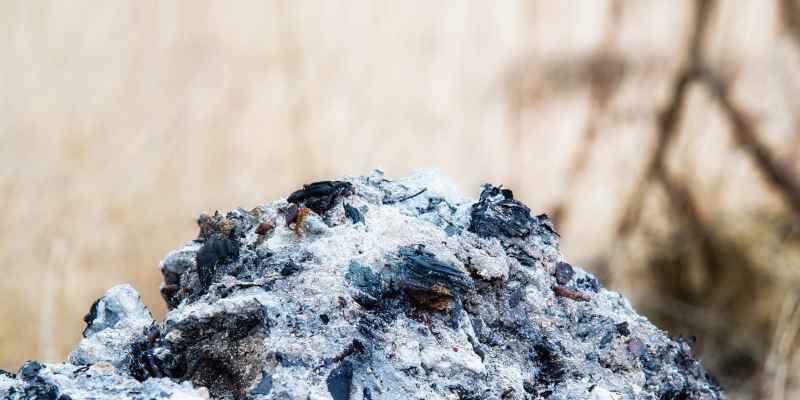To dispose of wood ash, you can spread it in your garden as a natural fertilizer. Alternatively, you can mix it with compost or dispose of it in your regular trash.
Wood ash can be a valuable resource for your garden and household waste management. When used properly, it can enrich the soil with essential nutrients and help maintain a healthy environment. However, it’s important to be mindful of how you dispose of wood ash to avoid any negative impacts on the surroundings.
In this blog, we will explore the various methods of disposing of wood ash and the benefits it can bring to your gardening and waste management practices. Whether you’re a seasoned gardener or someone looking to minimize household waste, understanding the proper disposal of wood ash can be beneficial for both you and the environment.
Introduction To Wood Ash Disposal
Wood ash, a byproduct of burning wood in fireplaces, stoves, or outdoor fire pits, can be a valuable resource when disposed of properly. Proper disposal of wood ash is essential to ensure environmental and safety considerations are met. In this article, we will explore the importance of proper wood ash disposal and the various types of wood ash that can be generated.
Why Proper Disposal Matters
Improper disposal of wood ash can have detrimental effects on the environment and pose risks to human and animal health. Acidic wood ash can harm plants and aquatic life, while alkaline wood ash can affect soil pH levels. Proper disposal helps prevent these negative impacts and promotes sustainable waste management practices.
Types Of Wood Ash
Wood ash can be categorized into two main types: hardwood ash and softwood ash. Hardwood ash, derived from trees like oak and maple, tends to have a higher nutrient content and can be beneficial for soil amendment. Softwood ash, from trees such as pine and fir, may contain higher levels of resins and tars, which can impact its suitability for certain uses.
Benefits Of Wood Ash
Enriching Soil Health
Wood ash contains essential nutrients like potassium and calcium.
It helps balance soil pH levels, promoting plant growth.
Natural Pest Control
Wood ash acts as a barrier against slugs and snails in gardens.
It repels insects like ants and beetles naturally.
Safety Precautions
Dispose of wood ash safely by letting it cool completely before putting it in a metal container. Avoid mixing it with other materials and keep it away from flammable items. Seal the container tightly and store it in a dry place until you can properly dispose of it.
Wood ash is a great addition to the garden, but it can also be dangerous if not handled properly. Before you dispose of your wood ash, there are a few safety precautions you should take to ensure that you and your family stay safe.
Avoiding Toxicity
One of the main dangers of wood ash is its potential to be toxic. Wood ash contains heavy metals like lead, cadmium, and arsenic, which can be harmful to humans and animals if ingested or inhaled. To avoid toxicity, it’s important to handle wood ash with care.
When handling wood ash, always wear gloves and a dust mask to protect your skin and lungs from any harmful particles. It’s also important to avoid breathing in any dust or ash particles, so work in a well-ventilated area or wear a respirator if necessary.
Proper Storage Techniques
To keep your wood ash safe and prevent any accidental fires, it’s important to store it properly. Always keep your wood ash in a metal container with a tight-fitting lid to prevent any sparks or embers from escaping.
When storing wood ash, never mix it with other materials like paper, cardboard, or chemicals. This can create a dangerous chemical reaction that could cause a fire or explosion.
If you plan to use your wood ash as a fertilizer, store it separately from any ash that may contain charcoal or other materials that could be harmful to plants.
In Conclusion
Disposing of wood ash can be a simple and safe process if you follow the proper safety precautions. Always wear protective gear, store your ash properly, and avoid mixing it with other materials. By taking these simple steps, you can enjoy all the benefits of wood ash in your garden while keeping your family safe.
Eco-friendly Disposal Methods
When it comes to disposing of wood ash, there are eco-friendly methods that not only help reduce waste but also benefit the environment. By utilizing wood ash in sustainable ways, you can contribute to the health of your garden and reduce your ecological footprint.
Composting With Wood Ash
Composting with wood ash can be an eco-friendly way to dispose of it. Mix small amounts of wood ash into your compost pile to help maintain a neutral pH level. However, it’s essential to use wood ash sparingly as it contains potassium, calcium, and other essential minerals that can benefit the composting process. Avoid adding too much wood ash as it can increase the pH level and potentially harm the microbial activity in the compost.
Using Ash In Your Garden
Wood ash can also be used directly in your garden to enhance the soil. Sprinkle a thin layer of wood ash around plants to provide potassium and calcium, which are essential for plant growth. Keep in mind that wood ash should be applied in moderation, as excessive use can negatively affect the soil pH. Additionally, avoid using wood ash on acid-loving plants such as blueberries, rhododendrons, and azaleas.
Indoor Uses For Wood Ash
Wood ash can be a useful substance with various indoor uses, such as cleaning surfaces, deodorizing the fridge, and repelling insects. When disposing of wood ash, it’s important to ensure it’s completely cooled down and to avoid mixing it with other materials.
Cleaning Agent
Wood ash can be a fantastic natural cleaning agent for various surfaces in your home. Its abrasive texture helps to remove tough stains and grime without damaging the material. To use wood ash as a cleaning agent, simply sprinkle a small amount onto a damp cloth or sponge and gently scrub the desired surface. Whether it’s a greasy stove, dirty oven, or even stained porcelain, wood ash can effectively cut through the dirt and leave your surfaces looking clean and shiny.
Odor Neutralizer
If you’re dealing with unpleasant odors in your home, wood ash can come to the rescue as a natural odor neutralizer. Its alkaline properties help to absorb and eliminate odors, leaving your indoor spaces smelling fresh and clean. To use wood ash as an odor neutralizer, simply place a small bowl of it in areas where odors are present, such as near garbage cans, pet areas, or even in the bathroom. The wood ash will work to absorb the odors and leave a more pleasant scent in the air.
Table:
| Indoor Uses for Wood Ash |
|---|
| Cleaning Agent |
| Odor Neutralizer |
In conclusion, wood ash has multiple indoor uses that can benefit your home. Whether it’s as a cleaning agent to tackle tough stains or as an odor neutralizer to freshen up your living spaces, wood ash proves to be a versatile and natural solution. So, instead of throwing away your wood ash, consider using it for these indoor purposes and reap the benefits it has to offer.
Creative Reuses Of Wood Ash

Wood ash can be creatively repurposed instead of being discarded. Explore unique ways to reuse wood ash, such as using it as a natural fertilizer for plants, a cleaning agent, or even as a natural pest repellent. Discover the numerous possibilities for giving wood ash a new purpose instead of simply disposing of it.
Wood ash is a natural byproduct of burning wood. Instead of disposing of it, there are several creative ways to reuse it. In this blog post, we will focus on two creative reuses of wood ash: making soap and crafting glazes for pottery.
Making Soap
Wood ash can be used to make soap due to its high potassium content, which is an essential ingredient in soap-making. Here’s how you can use wood ash to make soap:
- Collect wood ash and filter it to remove any large particles.
- Mix the filtered wood ash with water to create a lye solution.
- Mix the lye solution with oils, such as olive oil or coconut oil.
- Stir the mixture until it thickens, then pour it into molds.
- Let the soap cure for several weeks before using it.
Crafting Glazes For Pottery
Wood ash can also be used to make glazes for pottery. The high levels of calcium and potassium in wood ash make it an excellent ingredient for creating natural glazes. Here’s how you can use wood ash to make glazes for pottery:
| Materials | Instructions |
|---|---|
| Wood ash | Collect wood ash and filter it to remove any large particles. |
| Clay | Mix the filtered wood ash with clay in a 50:50 ratio. |
| Water | Add water to the mixture to create a paste. |
| Firing | Apply the glaze to your pottery and fire it in a kiln. |
By reusing wood ash, you can create natural soap and pottery glazes while reducing waste. Give these creative reuses of wood ash a try and see what you can create!
Community And Legal Considerations
When considering how to dispose of wood ash, it’s crucial to be mindful of both community and legal considerations.
Local Disposal Regulations
Local disposal regulations vary, so it’s essential to check with your municipality for specific guidelines.
Community Sharing Programs
Community sharing programs can be a sustainable option to repurpose wood ash in your local area.

Frequently Asked Questions
How Should I Dispose Of Wood Ash?
Wood ash can be disposed of by using it as a fertilizer in your garden or compost pile. Simply sprinkle a thin layer of ash around your plants or mix it into your compost. However, avoid using ash from treated wood or coal, as they may contain harmful chemicals.
Is Wood Ash Good For Plants?
Yes, wood ash is beneficial for plants as it contains essential nutrients like potassium, calcium, and magnesium. These nutrients help improve soil pH, promote plant growth, and increase the availability of other nutrients. However, it is important to use ash in moderation, as excessive amounts can raise the pH levels and harm certain plants.
Can I Use Wood Ash In My Compost?
Yes, wood ash can be added to your compost pile. It helps to neutralize acidity and add valuable nutrients to the compost. However, it’s important to use ash in moderation and mix it well with other compost materials to avoid creating an imbalance in the nutrient content.
Avoid using ash from treated wood or coal, as they may contain harmful chemicals.
Conclusion
Proper disposal of wood ash is crucial for safety and environmental reasons. By following these tips, you can ensure responsible handling of wood ash. Remember to check local regulations and explore creative ways to repurpose wood ash in your gardening or cleaning routines.
Make the most of this natural byproduct!


